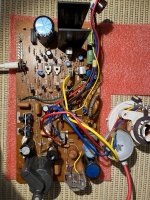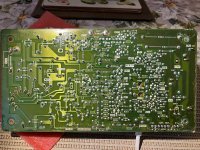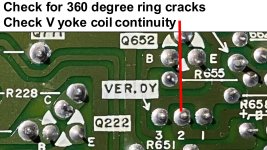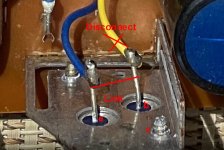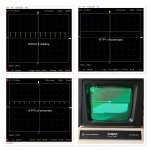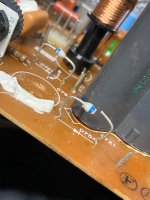daver2
10k Member
The electron gun within the CRT provides a single spot of light in the centre of the screen (when it strikes the phosphor at any rate).
The electron beam is deflected in the horizontal and vertical directions EXTERNALLY to the CRT by means of the scan coil assembly.
As Hugo says, the fact that you get a horizontal line is very good, as it demonstrates that the CRT is working with the PET electronics OK. The horizontal deflection electronics is also working fine. This is also responsible for the internal high voltages to the CRT.
I, personally, would have done a few checks before swapping the CRT over, as you could have damaged both the PET monitor electronics AND the CRT in the process! It seems lady luck is on your side today!
Turn the brightness potentiometer all the way down to dim the line for now and don't operate the monitor for too long like this. The line will be bright, as it is not sweeping the whole screen but the same part of the screen over and over. You could damage the phosphor if you operate it for too long like this.
Ah, but you say you can't adjust the brightness... I wonder if you can't adjust the brightness enough to compensate for the fault, rather than not at all?
There are three signals from the PET logic board to the monitor - HDRIVE, VDRIVE and VIDEO.
We know HDRIVE is OK (as you get a horizontal line). Can you check for activity on VDRIVE. It is most likely present, but let's be sure. You can do this test with the monitor disconnected.
The vertical deflection electronics within the monitor is very simple.
Can you post a photograph of the PET monitor board so we can lookup the schematics for it.
Dave
The electron beam is deflected in the horizontal and vertical directions EXTERNALLY to the CRT by means of the scan coil assembly.
As Hugo says, the fact that you get a horizontal line is very good, as it demonstrates that the CRT is working with the PET electronics OK. The horizontal deflection electronics is also working fine. This is also responsible for the internal high voltages to the CRT.
I, personally, would have done a few checks before swapping the CRT over, as you could have damaged both the PET monitor electronics AND the CRT in the process! It seems lady luck is on your side today!
Turn the brightness potentiometer all the way down to dim the line for now and don't operate the monitor for too long like this. The line will be bright, as it is not sweeping the whole screen but the same part of the screen over and over. You could damage the phosphor if you operate it for too long like this.
Ah, but you say you can't adjust the brightness... I wonder if you can't adjust the brightness enough to compensate for the fault, rather than not at all?
There are three signals from the PET logic board to the monitor - HDRIVE, VDRIVE and VIDEO.
We know HDRIVE is OK (as you get a horizontal line). Can you check for activity on VDRIVE. It is most likely present, but let's be sure. You can do this test with the monitor disconnected.
The vertical deflection electronics within the monitor is very simple.
Can you post a photograph of the PET monitor board so we can lookup the schematics for it.
Dave
Last edited:

